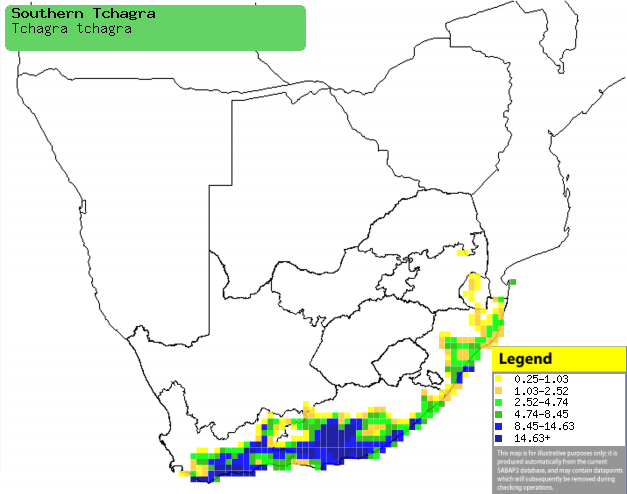|
Tchagra tchagra (Southern
tchagra)
Grysborstjagra [Afrikaans]; Umnguphane (generic term
for tchagra) [Xhosa]; Kaapse tsjagra [Dutch]; Tchagra du Cap [French];
Kaptschagra [German]; Picanço-assobiador-austral [Portuguese]
Life
> Eukaryotes >
Opisthokonta
> Metazoa (animals) >
Bilateria >
Deuterostomia > Chordata >
Craniata > Vertebrata (vertebrates) > Gnathostomata (jawed
vertebrates) > Teleostomi (teleost fish) > Osteichthyes (bony fish) > Class:
Sarcopterygii (lobe-finned
fish) > Stegocephalia (terrestrial
vertebrates) > Tetrapoda
(four-legged vertebrates) > Reptiliomorpha > Amniota >
Reptilia (reptiles) >
Romeriida > Diapsida > Archosauromorpha > Archosauria >
Dinosauria
(dinosaurs) > Saurischia > Theropoda (bipedal predatory dinosaurs) >
Coelurosauria > Maniraptora > Aves
(birds) >
Order: Passeriformes
> Family: Malaconotidae
Distribution and habitat
Endemic to South Africa and Swaziland, occurring from the
Western Cape to KwaZulu-Natal bordering on Mpumalanga. It is common throughout
most of its range, although it is more localized in Mpumalanga, Swaziland and
eastern KwaZulu-Natal. It mainly occupies coastal, thorny thickets, edges of
coastal dune forest, tangled fynbos and dense Acacia stands.
|
 |
|
Distribution of Southern tchagra in southern Africa,
based on statistical smoothing of the records from first SA Bird Atlas
Project (©
Animal Demography unit, University of
Cape Town; smoothing by Birgit Erni and Francesca Little). Colours range
from dark blue (most common) through to yellow (least common).
See here for the latest distribution
from the SABAP2. |
Brood parasites
It has been recorded as host of the
Jacobin cuckoo.
Food
It mainly eats insects, foraging close to the ground,
turning over bits of vegetation looking for prey. It also gleans insects from
leaves and branches and eats fallen seeds and fruit. The following food items
have been recorded in its diet:
- Insects
- Pugnacious ants, taken directly from their nest
- grasshoppers
- small beetles
- spiders
- small fruits
- seeds
Breeding
- The nest is probably built by both sexes, and consists of a shallow cup
built of fine plant stems, twigs and rootlets, the inside lined with finer
rootlets and hair. In the Western Cape it is usually placed in the fork of
thick scrub or bush, but further east it also puts it at the base of Aloe
ferox (Bitter aloe) as well as in tangled creepers growing over
cabbage-tree (Cussonia).
- It lays 2-3 white eggs with coloured dots and streaks, which are
incubated for about 15-16 days.
- The chicks are brooded almost constantly for the first 8-10 days or so,
after which brooding almost completely ceases. They are cared for by both
parents, leaving the nest after about 13-16 days.
Threats
Not threatened, in fact common in areas of South Africa.
References
-
Hockey PAR, Dean WRJ and Ryan PG 2005. Roberts
- Birds of southern Africa, VIIth ed. The Trustees of the John Voelcker
Bird Book Fund, Cape Town.
|
